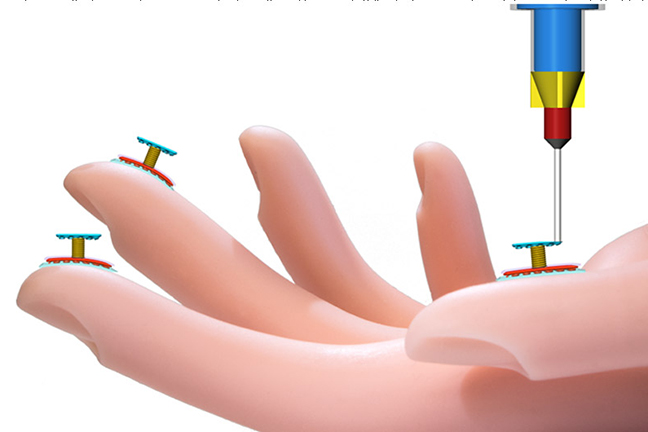A new frontier for robotics could be crossed with the development of stretchy sensors that can be 3D printed onto a variety of surfaces. The technology, developed by a team at the University of Minnesota, can also potentially be used to print electronics directly onto human skin, where it could be used for remote health monitoring.

The project was led by Prof Michael McAlpine, who while working at Princeton in 2013 devised a method for printing a bionic ear by integrating a printed coil antenna with the structure made of cartilage.
For the current project, McAlpine's team developed a customised 3D printer with four nozzles to print specialised "inks” that make up the sensors. The base layer of the construction is silicone, two subsequent layers are conducting inks that make up the sensor electrodes themselves, on top of these is a coil-shaped pressure sensor, and finally there is a soluble layer to hold everything together and is dissolved away once the structure is complete. All of the inks set at room temperature, and can stretch up to three times their original size.
"We have a multifunctional printer that can print several layers to make these flexible sensory devices. This could take us into so many directions from health monitoring to energy harvesting to chemical sensing," McAlpine said. "This is a completely new way to approach 3D printing of electronics."
In a paper in the journal Advanced Materials, McAlpine explains the project and suggests using the sensors on surgical robots to give their operators the ability to feel while performing minimally-invasive surgery, adding another layer of feedback to help in the surgery along with he visual systems using cameras that currently are the only aid to robotic surgery. Also, he added in a press release issued by the university, robots could use them to give feedback on their surroundings, helping them to walk and interact with objects or people.
"While we haven't printed on human skin yet, we were able to print on the curved surface of a model hand using our technique," McAlpine said. "We also interfaced a printed device with the skin and were surprised that the device was so sensitive that it could detect your pulse in real time." Such functionality could could eventually be used for health monitoring, or by soldiers in the field to detect dangerous chemicals or explosives, he added.
Because manufacturing is ”built in” to the discovery, it does not need to be scaled up, McAlpine added. The team now plans to move to semiconductor inks and printing onto living skin.
See the system in action here:




Poll: Should the UK’s railways be renationalised?
Rail passenger numbers declined from 1.27 million in 1946 to 735,000 in 1994 a fall of 42% over 49 years. In 2019 the last pre-Covid year the number...